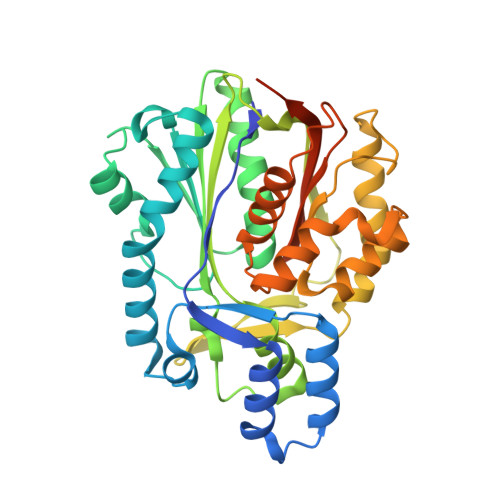Crystal structure of a bacterial type III polyketide synthase and enzymatic control of reactive polyketide intermediates
Austin, M.B., Izumikawa, M., Bowman, M.E., Udwary, D.W., Ferrer, J.L., Moore, B.S., Noel, J.P.(2004) J Biol Chem 279: 45162-45174
- PubMed: 15265863
- DOI: https://doi.org/10.1074/jbc.M406567200
- Primary Citation of Related Structures:
1U0M - PubMed Abstract:
In bacteria, a structurally simple type III polyketide synthase (PKS) known as 1,3,6,8-tetrahydroxynaphthlene synthase (THNS) catalyzes the iterative condensation of five CoA-linked malonyl units to form a pentaketide intermediate. THNS subsequently catalyzes dual intramolecular Claisen and aldol condensations of this linear intermediate to produce the fused ring tetrahydroxynaphthalene (THN) skeleton. The type III PKS-catalyzed polyketide extension mechanism, utilizing a conserved Cys-His-Asn catalytic triad in an internal active site cavity, is fairly well understood. However, the mechanistic basis for the unusual production of THN and dual cyclization of its malonyl-primed pentaketide is obscure. Here we present the first bacterial type III PKS crystal structure, that of Streptomyces coelicolor THNS, and identify by mutagenesis, structural modeling, and chemical analysis the unexpected catalytic participation of an additional THNS-conserved cysteine residue in facilitating malonyl-primed polyketide extension beyond the triketide stage. The resulting new mechanistic model, involving the use of additional cysteines to alter and steer polyketide reactivity, may generally apply to other PKS reaction mechanisms, including those catalyzed by iterative type I and II PKS enzymes. Our crystal structure also reveals an unanticipated novel cavity extending into the "floor" of the traditional active site cavity, providing the first plausible structural and mechanistic explanation for yet another unusual THNS catalytic activity: its previously inexplicable extra polyketide extension step when primed with a long acyl starter. This tunnel allows for selective expansion of available active site cavity volume by sequestration of aliphatic starter-derived polyketide tails, and further suggests another distinct protection mechanism involving maintenance of a linear polyketide conformation.
Organizational Affiliation:
Structural Biology Laboratory, The Salk Institute for Biological Studies, La Jolla, California 92037, USA.
















